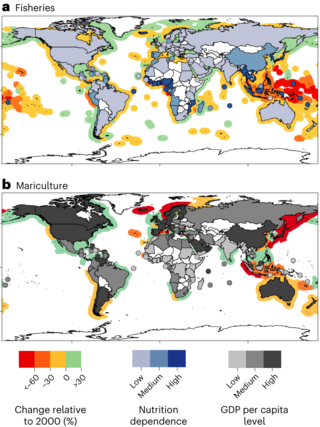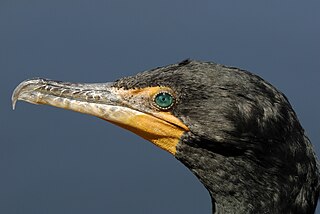Related Research Articles

Aquaculture, also known as aquafarming, is the controlled cultivation ("farming") of aquatic organisms such as fish, crustaceans, mollusks, algae and other organisms of value such as aquatic plants. Aquaculture involves cultivating freshwater, brackish water and saltwater populations under controlled or semi-natural conditions, and can be contrasted with commercial fishing, which is the harvesting of wild fish. Aquaculture is also a practice used for restoring and rehabilitating marine and freshwater ecosystems. Mariculture, commonly known as marine farming, is aquaculture in seawater habitats and lagoons, as opposed to freshwater aquaculture. Pisciculture is a type of aquaculture that consists of fish farming to obtain fish products as food.

Mariculture, sometimes called marine farming or marine aquaculture, is a specialized branch of aquaculture involving the cultivation of marine organisms for food and other animal products, in enclosed sections of the open ocean, fish farms built on littoral waters, or in artificial tanks, ponds or raceways which are filled with seawater. An example of the latter is the farming of marine fish, including finfish and shellfish like prawns, or oysters and seaweed in saltwater ponds. Non-food products produced by mariculture include: fish meal, nutrient agar, jewellery, and cosmetics.

Fish farming or pisciculture involves commercial breeding of fish, most often for food, in fish tanks or artificial enclosures such as fish ponds. It is a particular type of aquaculture, which is the controlled cultivation and harvesting of aquatic animals such as fish, crustaceans, molluscs and so on, in natural or pseudo-natural environments. A facility that releases juvenile fish into the wild for recreational fishing or to supplement a species' natural numbers is generally referred to as a fish hatchery. Worldwide, the most important fish species produced in fish farming are carp, catfish, salmon and tilapia.

Fishery can mean either the enterprise of raising or harvesting fish and other aquatic life or, more commonly, the site where such enterprise takes place. Commercial fisheries include wild fisheries and fish farms, both in freshwater waterbodies and the oceans. About 500 million people worldwide are economically dependent on fisheries. 171 million tonnes of fish were produced in 2016, but overfishing is an increasing problem, causing declines in some populations.

The Pacific Islands Forum (PIF) is an inter-governmental organization that aims to enhance cooperation among countries and territories of Oceania, including formation of a trade bloc and regional peacekeeping operations. It was founded in 1971 as the South Pacific Forum (SPF), and changed its name in 1999 to "Pacific Islands Forum", so as to be more inclusive of the Forum's Oceania-spanning membership of both north and south Pacific island countries, including Australia. It is a United Nations General Assembly observer.
Sustainable seafood is seafood that is caught or farmed in ways that consider the long-term vitality of harvested species and the well-being of the oceans, as well as the livelihoods of fisheries-dependent communities. It was first promoted through the sustainable seafood movement which began in the 1990s. This operation highlights overfishing and environmentally destructive fishing methods. Through a number of initiatives, the movement has increased awareness and raised concerns over the way our seafood is obtained.

Crab fisheries are fisheries which capture or farm crabs. True crabs make up 20% of all crustaceans caught and farmed worldwide, with about 1.4 million tonnes being consumed annually. The horse crab, Portunus trituberculatus, accounts for one quarter of that total. Other important species include flower crabs, snow crabs (Chionoecetes), blue crabs, edible or brown crabs, Dungeness crab, and mud crabs, each of which provides more than 20,000 tonnes annually.

China has one-fifth of the world's population and accounts for one-third of the world's reported fish production as well as two-thirds of the world's reported aquaculture production. It is also a major importer of seafood and the country's seafood market is estimated to grow to a market size worth US$53.5 Billion by 2027.

Aquaculture started to take off in New Zealand in the 1980s. It is dominated by mussels, oysters and salmon. In 2007, aquaculture generated about NZ$360 million in sales on an area of 7,700 hectares. $240 million was earned in exports.
Aquaculture in Vanuatu exists on a small scale, both commercially and privately. Several aquacultural efforts have been made in the country, including attempts to raise Pacific oyster, rabbitfish, Malaysian prawn, and tilapia. Experiments with Kappaphycus alvarezii and three species of giant clam were carried out by the Fisheries Department in 1999. The official Fisheries Department records state that $1165 US of cultured coral was exported from the country in 2000, with 275 pieces in total. The cultivation of Macrobrachium lar in taro terraces is practiced for subsistence purposes, and Macrobrachium rosenbergii has been identified by the Vanuatu government as a high-priority species.
Aquaculture in the Marshall Islands is governed by the Marshall Islands Marine Resources Authority. A hatchery for giant clams has been established by the national government in Likiep Atoll, and at least one other clam farm is in operation in Mili Atoll. At the CSD-16 Partnerships Fair in 2008, Erik Hagberg suggested that Holothuroidea cultivation is a viable option for developing aquaculture in the country.
Aquaculture in Samoa is hampered because of the limited number of sizable freshwater bodies in the country, although numerous aquaculture projects are underway. There have been several attempts to introduce tilapia cultivation, however these have generally been unsuccessful due to flooding as well as the difficulty of catching adult tilapia. The Samoa National Aquaculture Workshop, a workshop intended to develop a national industry plan by seeking out partnerships with stakeholders, convened in December 2004.
Aquaculture in Tuvalu generally centers on milkfish and clams. The first pond in Tuvalu purposely built to sustain aquaculture was completed in 1996 on Vaitupu. The construction of this 1560-square-metre pond was funded under the FAO Regional South Pacific Aquaculture Development Project.
Aquaculture in Tonga has been the responsibility of the Ministry of Fisheries since the early 1970s. The main centre for this is the Sopu Mariculture Centre on the main island of Tongatapu, which is operated by the Ministry of Fisheries and was established with the assistance of the Government of Japan. A serious setback was experienced in 1982 as a result of damage caused by Cyclone Isaac.

The aquaculture of salmonids is the farming and harvesting of salmonid fish under controlled conditions for both commercial and recreational purposes. Salmonids, along with carp and tilapia, are the three most important fish groups in aquaculture. The most commonly commercially farmed salmonid is the Atlantic salmon.

A shark sanctuary is an area that forbids commercial fishing operations from targeting and retaining caught sharks, including their fins. The first shark sanctuary was created by Palau in 2009. It was followed by Maldives, Honduras, The Bahamas and Tokelau.

Fisheries are affected by climate change in many ways: marine aquatic ecosystems are being affected by rising ocean temperatures, ocean acidification and ocean deoxygenation, while freshwater ecosystems are being impacted by changes in water temperature, water flow, and fish habitat loss. These effects vary in the context of each fishery. Climate change is modifying fish distributions and the productivity of marine and freshwater species. Climate change is expected to lead to significant changes in the availability and trade of fish products. The geopolitical and economic consequences will be significant, especially for the countries most dependent on the sector. The biggest decreases in maximum catch potential can be expected in the tropics, mostly in the South Pacific regions.

Aquaculture is the farming of fish, shellfish or aquatic plants in either fresh or saltwater, or both. The farmed animals or plants are cared for under a controlled environment to ensure optimum growth, success and profit. When they have reached an appropriate size, they are harvested, processed, and shipped to markets to be sold. Aquaculture is practiced all over the world and is extremely popular in countries such as China, where population is high and fish is a staple part of their everyday diet.

Geoduck aquaculture or geoduck farming is the practice of cultivating geoducks for human consumption. The geoduck is a large edible saltwater clam, a marine bivalve mollusk, that is native to the Pacific Northwest.

Cormorant culling is the intentional killing of cormorants by humans for the purposes of wildlife management. It has been practiced for centuries, with supporters of culling generally arising from the angling community. Culling techniques may involve the killing of birds, the destruction of eggs, or both. Historically, culls have occurred to protect the interests of recreational and commercial fishermen who perceive the animals to be competing with them for their intended catch or for the prey of their intended catch. Since the 1960s, the growing aquaculture industry has undertaken cormorant culls to protect its farmed fish and crustacean stocks. Opponents of cormorant culling include conservation groups such as the National Audubon Society, Cormorant Defenders International and Sea Shepherd.
References
- ↑ "Palau". Secretariat of the Pacific Community . Retrieved 2009-05-02.
- ↑ "Aquaculture and Fisheries Action Plan" (PDF). Property Institute of New Zealand. June 2008. Archived from the original (PDF) on 26 March 2009. Retrieved 2009-05-02.
- ↑ Simon Ellis (March 28, 2000). "s_ellis_032800.html". reefs.org. Retrieved 2009-05-02.